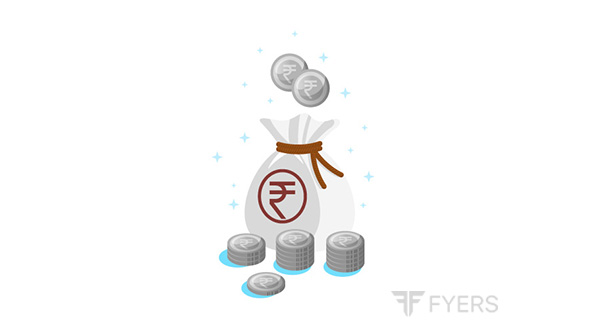
Silver is the little cousin of gold. It’s believed that mining of silver began around 3,000 years ago in Turkey. Since then, the metal has been widely used in the form of jewellery, for making ornaments, coins, medals etc. Silver is also heavily used in industries, because of which it is sometimes referred to as an industrial metal. As an investment, silver can be bought in physical form (such as in the shape of bars, coins, and bullion) as well as in financial form (such as silver Exchange Traded Funds or ETFs). It is traded around the world in various commodity exchanges. In India, the exchange where silver is most traded as a derivative instrument is on the MCX.
Silver demand
While gold is considered a precious metal, silver is considered both precious and an industrial metal. This can be seen by the demand composition for the metal. As can be seen in the chart, around three-fifths of silver’s demand comes from the industrial sector. Given the physical properties of silver, it is heavily used across a range of industrial applications. Over 40% of silver’s industrial demand comes 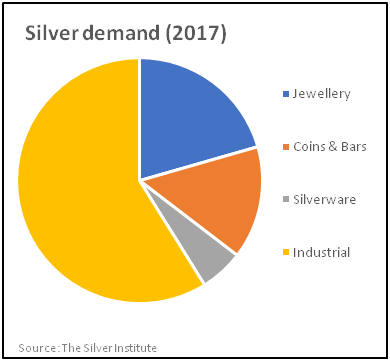 from the electrical and electronic side, given its widespread usage in almost all electrical and electronic devices. The photovoltaic segment contributes to over a sixth of silver’s industrial demand, with the metal being widely used in the production of solar cells as it is an exceptional conductor of electricity. Around 7% of silver’s industrial demand comes from photography, where the metal is used in traditional imaging devices. However, the share of silver in photography has halved in a decade, as digital imaging has taken over film-based imaging. In 2008, photography used to account of around 15% of industrial demand. That said, silver is still being used for imaging in x-ray machines, especially in developing nations where traditional imaging remains popular over digital imaging because of its lower cost.
from the electrical and electronic side, given its widespread usage in almost all electrical and electronic devices. The photovoltaic segment contributes to over a sixth of silver’s industrial demand, with the metal being widely used in the production of solar cells as it is an exceptional conductor of electricity. Around 7% of silver’s industrial demand comes from photography, where the metal is used in traditional imaging devices. However, the share of silver in photography has halved in a decade, as digital imaging has taken over film-based imaging. In 2008, photography used to account of around 15% of industrial demand. That said, silver is still being used for imaging in x-ray machines, especially in developing nations where traditional imaging remains popular over digital imaging because of its lower cost.
The second major source of demand for silver is jewellery, accounting for over a fifth of total silver demand. India occupies a lion’s share in silver jewellery, contributing to around a third of global jewellery demand. China, Thailand, Italy, and the US are the other major consumers of silver in the form of jewellery, together accounting for around two-fifths of total jewellery demand. Demand for silver in the form of jewellery is sensitive to price. It usually tends to pick up after a marked decline in price, and falter after a sustained up move in price.
The third major source of silver demand is investment, accounting for around a sixth of total silver demand. Investment demand comprises of silver ETFs, bars, and coins & medals. Of these, bars (~46%) and coins & medals (~52%) occupy a significant share, while ETFs (~2%) occupy a rather negligible share. This side of demand is not as sensitive to price as is jewellery demand. Instead, this side of demand reacts more to macro-economic developments, tending to rise during periods of uncertainties and decline during periods of economic strength. That said, as a major chunk of silver’s demand comes from industries uses, the metal is not considered as haven an asset as is gold. As such, inflows into silver in the form of investments are not as strong during periods of economic uncertainties as are inflows into gold. The opposite also holds true when economic conditions are robust.
Silver supply
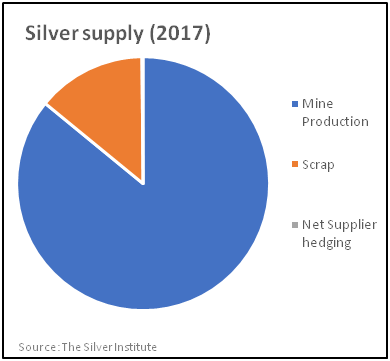 Mine production and scrap have accounted for a majority of silver supply (>99%) over the past few years, with producer hedging playing a negligible role (<1%). Central banks have not been selling silver since 2014 and hence, the supply from this source has ceded.
Mine production and scrap have accounted for a majority of silver supply (>99%) over the past few years, with producer hedging playing a negligible role (<1%). Central banks have not been selling silver since 2014 and hence, the supply from this source has ceded.
Mine production accounts for a bulk of global silver supply. In 2017, it contributed to around 86% of silver’s overall supply. Mexico is the largest mining nation of silver, accounting for a fourth of world mine production. Peru and China are the second and third largest producers, accounting for around 16% and 13% of global output, respectively. Together, these nations account for more than half of global production.
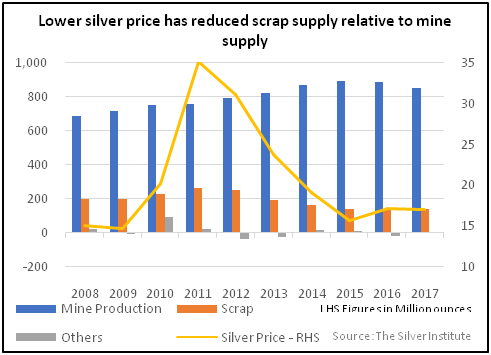 Scrap is the other major source of silver supply, contributing to around 14% of the metal’s global supply. The sector’s share in total supply has been gradually reducing over the years due to the declining trend in silver price, reducing the incentive to recycle, especially in key price-sensitive regions such as Asia. In 2011, when silver price registered its record high annual closing, scrap supplies from Asia stood at 101.6 million ounces. Since then, the steady decline in silver price has caused recycling from Asia to also head south, standing at just 44.4 million ounces in 2017. This highlights that scrap supply of silver is more responsive to immediate price changes than mine supply, which is more sensitive to price changes in the long-term.
Scrap is the other major source of silver supply, contributing to around 14% of the metal’s global supply. The sector’s share in total supply has been gradually reducing over the years due to the declining trend in silver price, reducing the incentive to recycle, especially in key price-sensitive regions such as Asia. In 2011, when silver price registered its record high annual closing, scrap supplies from Asia stood at 101.6 million ounces. Since then, the steady decline in silver price has caused recycling from Asia to also head south, standing at just 44.4 million ounces in 2017. This highlights that scrap supply of silver is more responsive to immediate price changes than mine supply, which is more sensitive to price changes in the long-term.
Factors that influence silver price
We will now talk about the key factors that influence the price of silver. As already stated, silver is primarily a precious metal, and hence its price movement in heavily influenced by the direction of gold. Also, given silver’s heavy usage in industries (remember that more than half of silver’s demand comes from the industrial sector), the price of the metal is also impacted by the health of the global economy. Because of silver’ close correlation with the price of gold, all factors that impact the price of gold also influence the price of silver. Hence, we will not be discussing about some of the factors that we have already discussed in the previous section of gold, namely, the US dollar, monetary policy, real rate of return, and physical demand. Instead, we will talk about how silver is impacted by the price of gold and how silver is impacted by risk appetite in general.
Gold
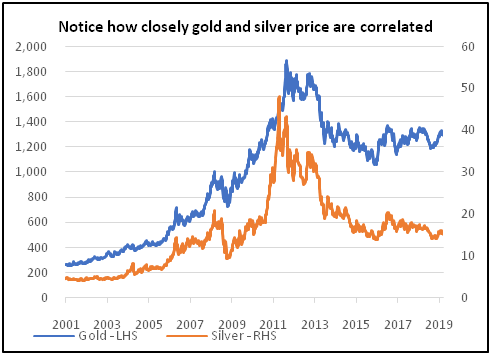 Being a precious metal, the price movement of silver is closely tied to that of gold. Observe in the chart that the two move in the same direction most of the time, peaking and bottoming at essentially the same time. That said, while the general price movement of silver remains in the same direction as that of gold, on occasions, there is a tendency for silver to deviate from gold. Observe in the chart that between 2016 till now, silver price has been underperforming gold, with the yellow metal forming higher lows and the grey metal forming lower lows. This again has got to do with silver’s dual role as a precious metal and an industrial metal. Over the past few years, global economy has been slowing led, led by slowdown in growth in China, which is the world’s largest consumer of metals. This in turn has caused gold to outperform silver. While both gold and silver tend to move in the same direction, there is a tendency for silver to outperform gold during periods of economic strength and underperform during periods of economic weakness.
Being a precious metal, the price movement of silver is closely tied to that of gold. Observe in the chart that the two move in the same direction most of the time, peaking and bottoming at essentially the same time. That said, while the general price movement of silver remains in the same direction as that of gold, on occasions, there is a tendency for silver to deviate from gold. Observe in the chart that between 2016 till now, silver price has been underperforming gold, with the yellow metal forming higher lows and the grey metal forming lower lows. This again has got to do with silver’s dual role as a precious metal and an industrial metal. Over the past few years, global economy has been slowing led, led by slowdown in growth in China, which is the world’s largest consumer of metals. This in turn has caused gold to outperform silver. While both gold and silver tend to move in the same direction, there is a tendency for silver to outperform gold during periods of economic strength and underperform during periods of economic weakness.
Another thing to keep in mind is that in terms of price movement, silver is more volatile than gold. In other words, silver has a higher beta than gold [since 2001, silver’s beta to gold (based on weekly closing price) has averaged 1.4, meaning for every 1% change in the price of gold, silver price on average changes by 1.4%]. Observe in the chart that between 2009 and 2011, silver price surged almost 5 times while gold price surged less than three times. Similarly, in the corresponding fall from 2011 to 2013, silver price plummeted nearly 60% from the peak while gold price declined less than 40%.
Global economic health
As already stated, silver is both a precious metal and an industrial metal. The factor that most impacts the price of silver is gold. However, silver is also impacted by the health of the global economy. While silver mostly moves in the direction that gold moves, there is a tendency for the grey metal to underperform or outperform its bigger cousin. The factor that most impacts this is global economic health. Usually, silver tends to outperform gold during times of global economic strength and underperform gold during times of global economic weakness. This again has got to do with the demand structure for silver. As we already know, more than half of silver’s demand comes from the industrial side. Hence, it is not surprising to see silver outperform gold during good economic times and underperform gold during bad economic times.
The chart above is the ratio chart of gold (numerator) to silver (denominator). In its simplest terms, this chart indicates how many ounces of silver are needed to buy one ounce of gold. Currently, the ratio is around 85, meaning around 85 ounces of silver are needed to buy 1 ounce of gold. Observe how silver outperformed gold from 2003 to 2008, a period when growth in China and other nations was robust, fuelling demand for industrial commodities, including silver. However, from 2008 to 2009, 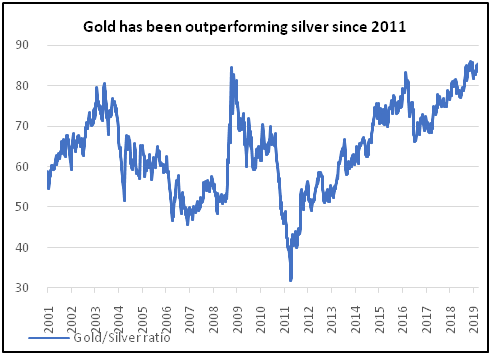 amid the worst financial turmoil since the Great Depression of the 1920s, demand for havens surged, causing silver to underperform gold as demand for industrial metals plunged. However, with central banks and governments around the world doing everything in their power to revive global economic conditions, including the usage of unconventional policies, silver again started to outperform gold from 2009 to 2011. Since then, with global monetary and fiscal policies normalizing and with economies from Europe to China slowing down, silver has again started to underperform gold, which has been the story from 2011 till present.
amid the worst financial turmoil since the Great Depression of the 1920s, demand for havens surged, causing silver to underperform gold as demand for industrial metals plunged. However, with central banks and governments around the world doing everything in their power to revive global economic conditions, including the usage of unconventional policies, silver again started to outperform gold from 2009 to 2011. Since then, with global monetary and fiscal policies normalizing and with economies from Europe to China slowing down, silver has again started to underperform gold, which has been the story from 2011 till present.
Gold to silver ratio is widely tracked by traders around the world for several reasons. It not only tells the relative movement of the two commodities, but it sometimes also gives clues about the general risk flows. During times when volatility and uncertainties escalate, there is a tendency for the ratio to spike up, and vice versa.
How to trade silver
In order to trade silver, one must keep in mind the following factors:
-
Because silver moves in the same direction in which gold moves, one must closely keep an eye on the trend of gold and the factors that impact gold price. If gold is expected to move higher, so would silver, and vice versa.
-
While silver tends to move in the same direction in which gold moves, there would be periods of underperformance or outperformance relative to gold. For this, one must track the ratio of gold to silver (gold price divided by silver price). If the ratio is heading higher, it means silver is underperforming gold, and vice versa.
-
Thegold to silver ratio can also be used to trade the two metals. For instance, a trader might buy silver and sell gold if the ratio is expected to go lower and do the opposite when the ratio is expected to go higher. Given silver is widely used in industries, it tends to outperform gold during periods of economic expansion, and vice versa.
Next Chapter
Comments & Discussions in
FYERS Community
dhir singh commented on May 10th, 2019 at 12:38 PM
interested
tejas commented on May 10th, 2019 at 8:00 PM
In trading silver or opening an account? ;)
Sagar kunte commented on June 5th, 2019 at 10:39 PM
As explained in Gold if the dollar is strengthening gold will become expensive will it be the same for silver also, As silver depends on other factors also.
tejas commented on June 6th, 2019 at 12:38 AM
Regardless of the other factors, if USD increases in value, the value of gold will rise in INR terms, all else being equal.
Kalyan m commented on June 5th, 2019 at 10:48 PM
Is it good to hedge gold with silver, since the price action is almost same
tejas commented on June 6th, 2019 at 12:39 AM
Yeah , you can if you've figured out if the correlations work in the timeframe of your trade.
Praveen k commented on June 6th, 2019 at 11:15 AM
Whenever the capital market is in downtrend the gold price will start increasing, will silver prices also increase when there is a down trend in capital market.
tejas commented on June 14th, 2019 at 1:04 AM
Silver is considered to be Gold's younger sibling. Historically Gold and Silver have moved in the same direction and are highly correlated. Yeah, since precious metals (Silver is both precious and an industrial metal) are considered to be proxy currency, they tend to go up during times of uncertainty when people need to park their money in safe haven assets, so to speak.
Aditya commented on July 15th, 2019 at 11:12 PM
Can i buy silver and close on same day of delivery intention date?
tejas commented on August 14th, 2019 at 5:05 PM
Hi Aditya, we don't allow intraday trading on delivery intention date. You can trade before delivery intention date.